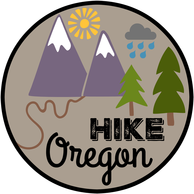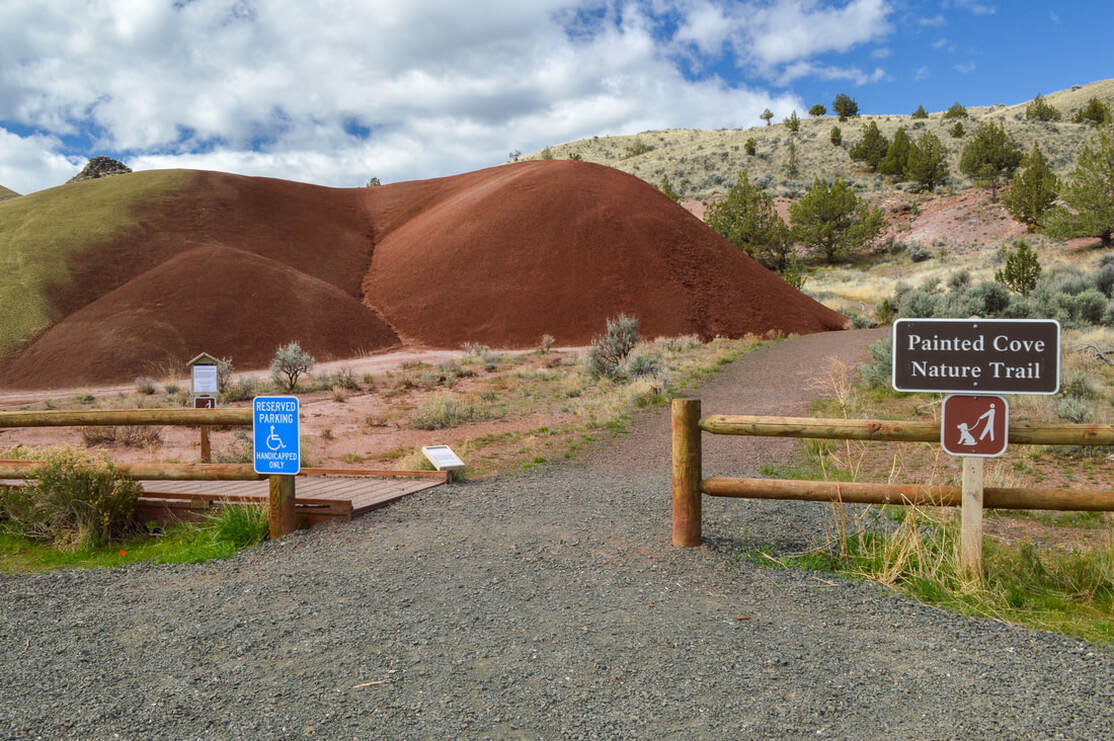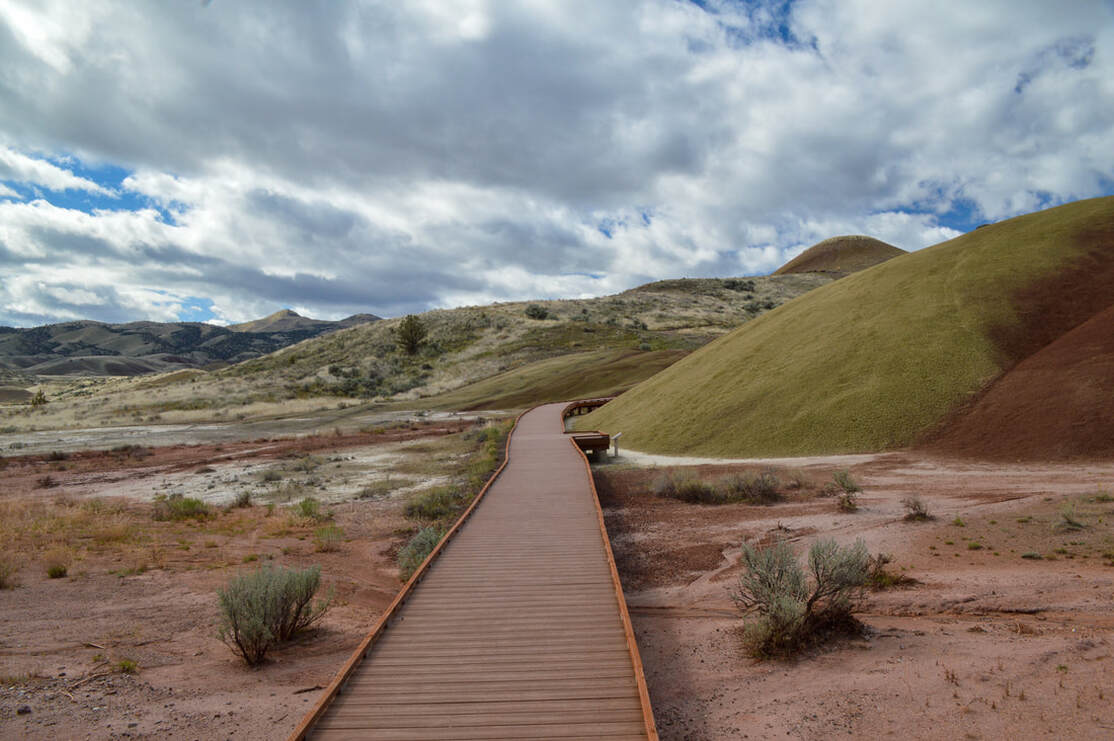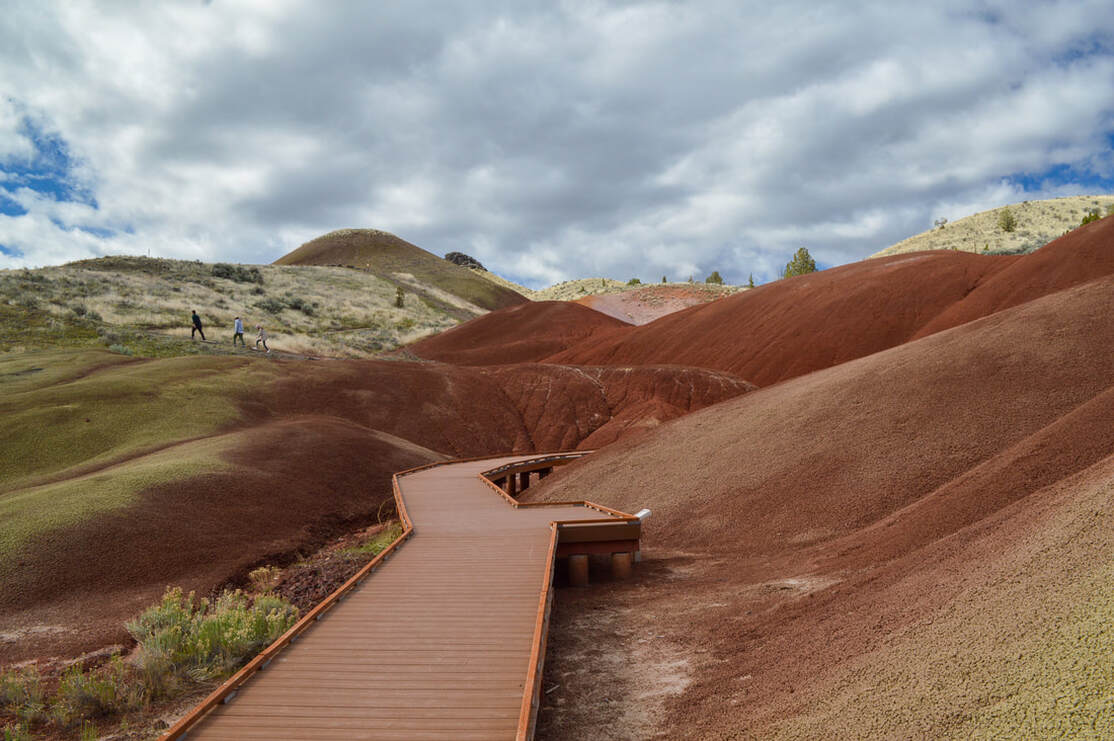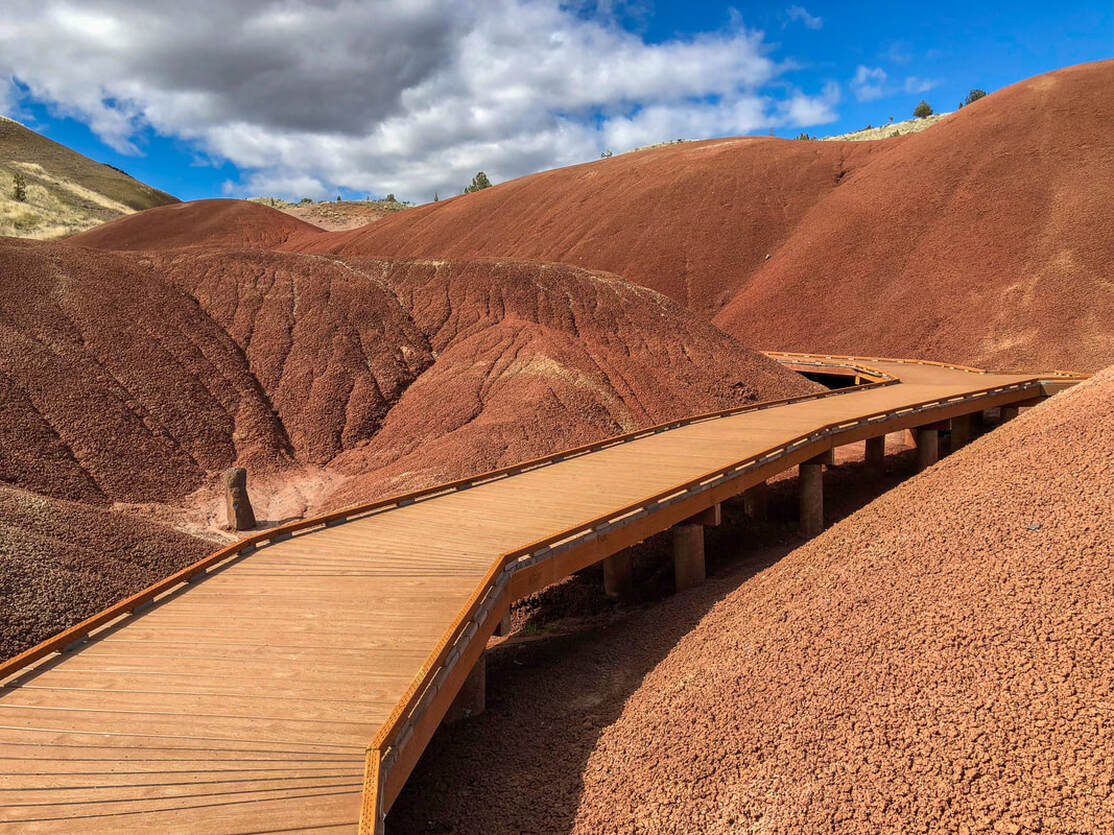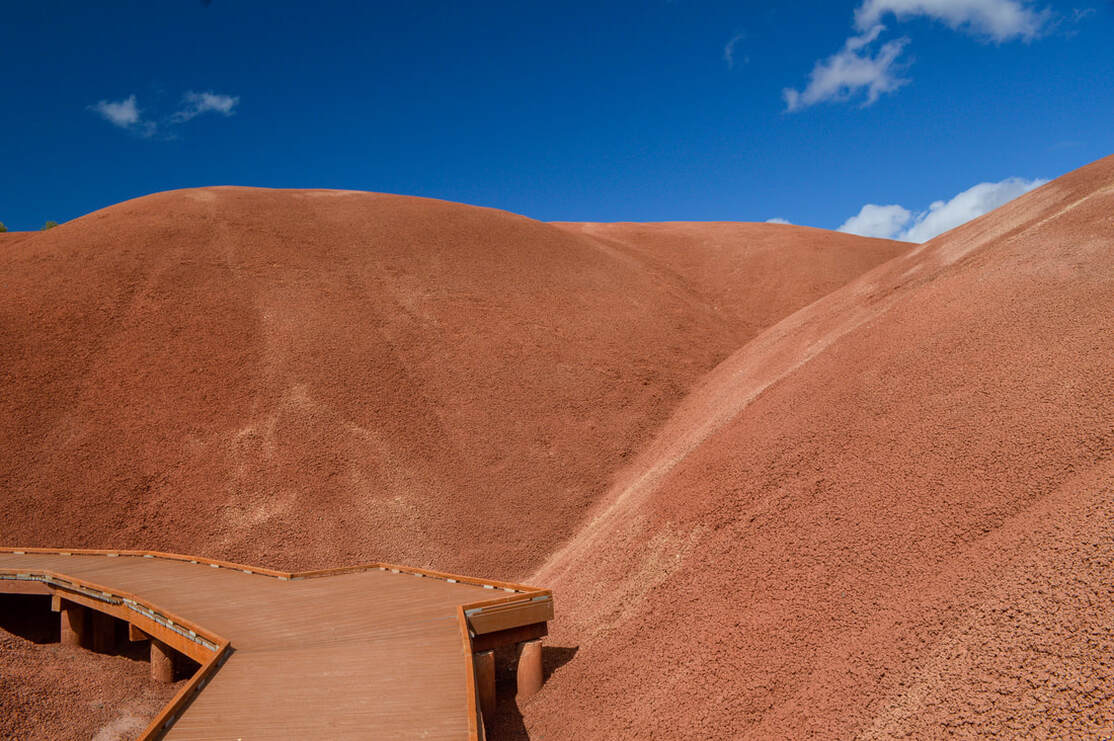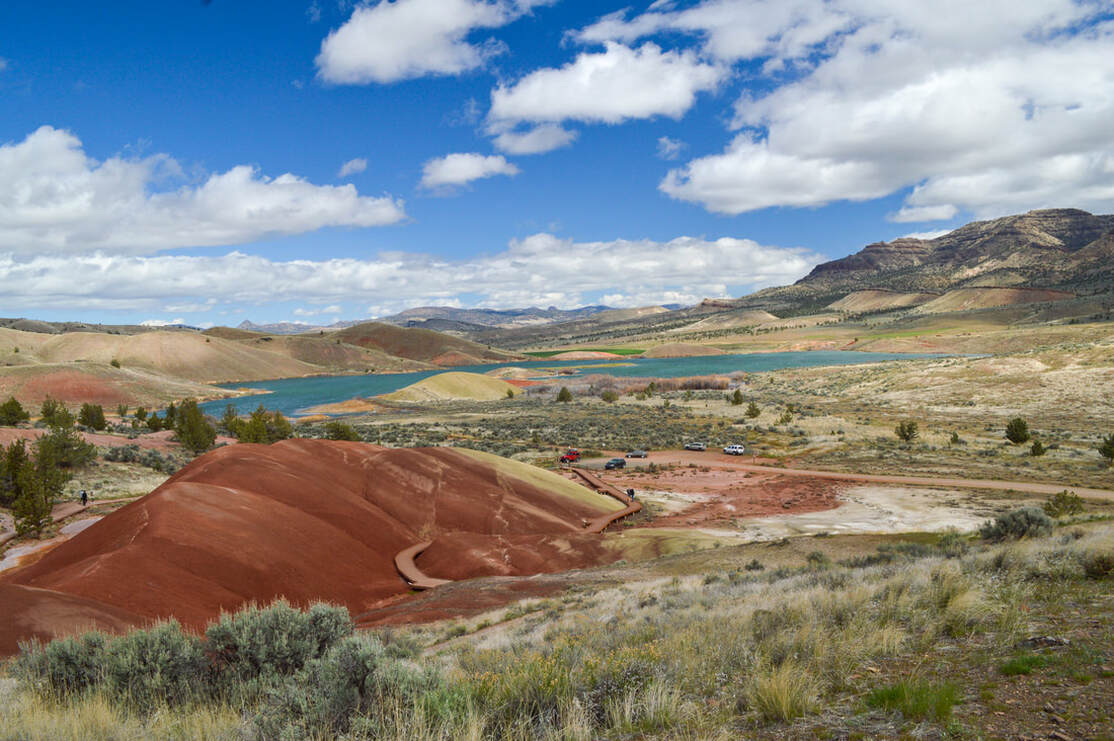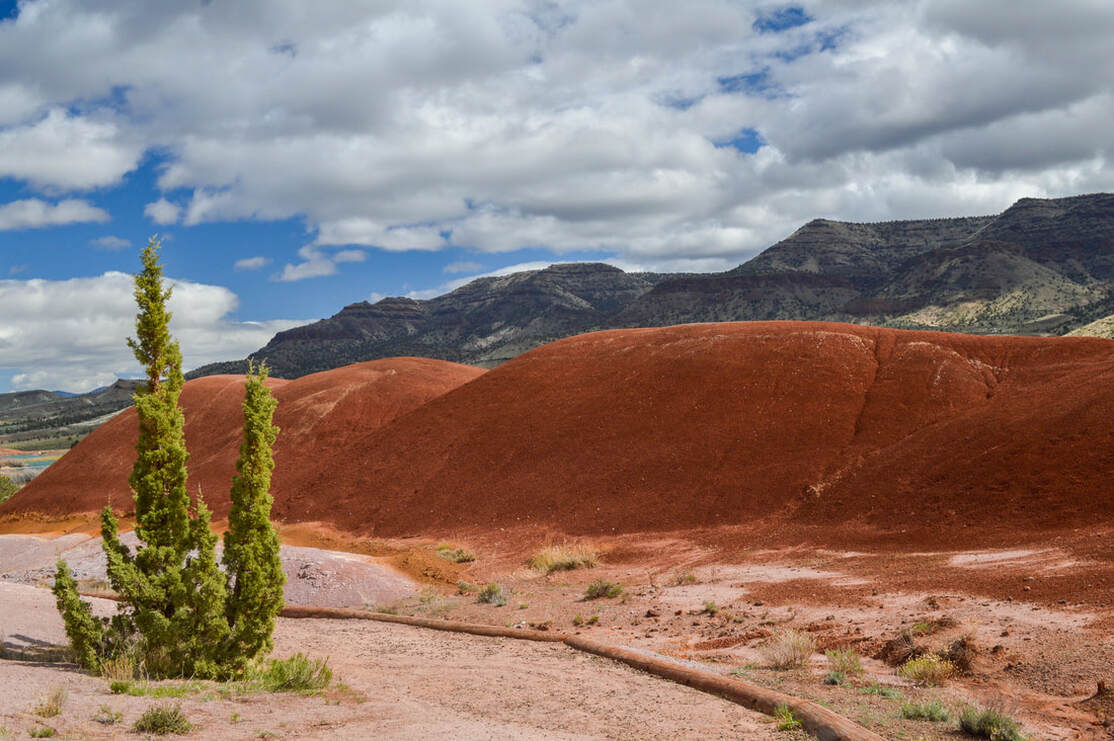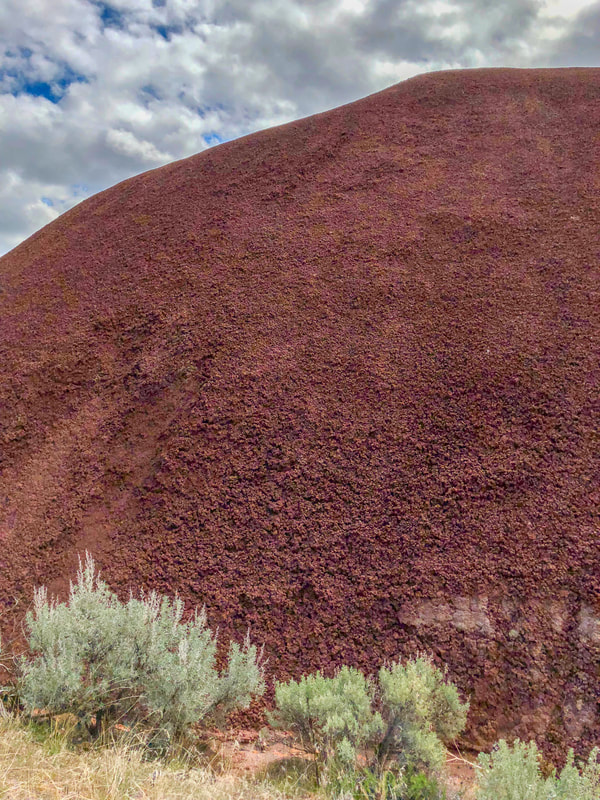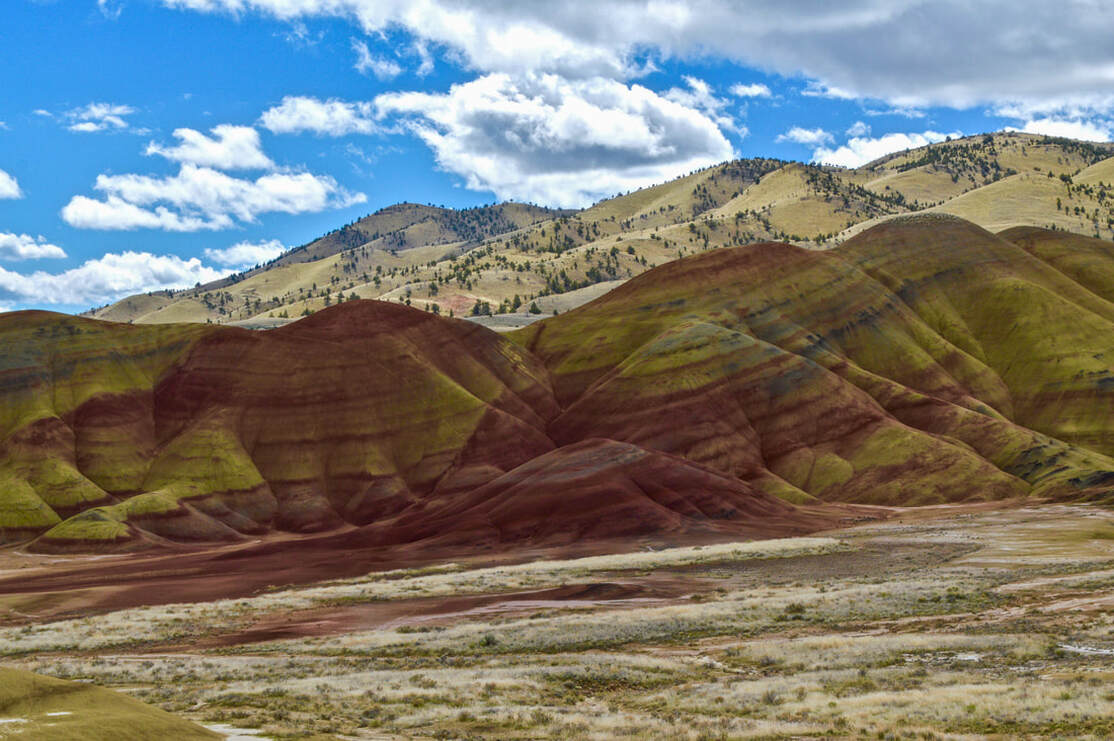Painted Cove
Hike details:
Mileage: 0.25 miles out and back w/ 50 ft. elevation gain
Approximate hike time: 25 - 30 minutes so that you can take the time to read all of the plaques and learn about the area.
Difficulty: Very easy
Trail usage: High on weekends in the summer, medium on weekends in the fall, winter and spring, medium on weekdays in the spring, low on weekdays in the fall, winter and spring.
Highest elevation: 1,925 ft. Lowest elevation: 1,875 ft.
General location: 70 miles northeast of Redmond - John Day Fossil Beds National Monument
Suggested seasons: Fall, winter, spring, summer (although summer is going to be hot)
(Best time to go during the spring is March, April and early May. Avoid summer months June, July August because it gets very hot and is not as enjoyable. Fall months are great as well September, October, November and early December. It can snow sometimes in late December, January and February and the roads can be icy).
Permits required: N/A
Pit toilet at trailhead: No (but there is one at the picnic area on the way in)
Trail allows: Dogs, wheelchairs
Possible dangers: N/A
Approximate hike time: 25 - 30 minutes so that you can take the time to read all of the plaques and learn about the area.
Difficulty: Very easy
Trail usage: High on weekends in the summer, medium on weekends in the fall, winter and spring, medium on weekdays in the spring, low on weekdays in the fall, winter and spring.
Highest elevation: 1,925 ft. Lowest elevation: 1,875 ft.
General location: 70 miles northeast of Redmond - John Day Fossil Beds National Monument
Suggested seasons: Fall, winter, spring, summer (although summer is going to be hot)
(Best time to go during the spring is March, April and early May. Avoid summer months June, July August because it gets very hot and is not as enjoyable. Fall months are great as well September, October, November and early December. It can snow sometimes in late December, January and February and the roads can be icy).
Permits required: N/A
Pit toilet at trailhead: No (but there is one at the picnic area on the way in)
Trail allows: Dogs, wheelchairs
Possible dangers: N/A
Description:
The John Day Fossil Beds National Monument has a lot to offer and because there are various units of the monument spread throughout the area, you could really spend a few days here discovering all of the trails and surrounding beauty and vast history of this incredibly unique place. The Painted Hills are one of the 7 Wonders of Oregon and the short loop trail through Painted Cove is definitely worth the stop.
Most people do the loop clockwise, but you can go either way. There are a total of 10 plaques along the way that tell the story of how these painted hills were formed. A big reminder, DO NOT step off the trail/boardwalk and onto the hills. Footprints will scar them and quicken the erosion. Every year the painted hills erode away a little bit with the rain.
Text from the plaque: Red and yellow clay layers mark different paleo environments. Red soils indicate a warm, wet period where swamps were common. Yellow clays point to a cooler, drier time dominated by hardwood forests.
Text from the plaque: Red and yellow clay layers mark different paleo environments. Red soils indicate a warm, wet period where swamps were common. Yellow clays point to a cooler, drier time dominated by hardwood forests.
As you enter into the hills there is a boardwalk built for very easy walking and wheelchair accessibility. Walking along the boardwalk is absolutely amazing as you go deeper into the hills. In the spring, flowers bloom along the sides of the walkway and there are many places where you can admire the texture and colors of the hills close up.
Text from the plaque: Volcanic ash along with organic debris from nearby hardwood forests washed into swampy basins, eventually forming water-logged soils in ancient wetlands. How did these slimy black swamp soils turn red?
Text from the plaque: Volcanic ash along with organic debris from nearby hardwood forests washed into swampy basins, eventually forming water-logged soils in ancient wetlands. How did these slimy black swamp soils turn red?
Text from the plaque: Like old metal, the hills are slowly oxidizing or rusting. About 33 million years ago, iron rich volcanic ash fell on this landscape. Weathering processes slowly changed new ash layers into fertile soils under forests and swamps. Over time, oxidizing irons stained the clay soils, forming the rusting red hills you see today.
After walking through the hills, the boardwalk ends and there is a small gravel path that you can take that goes up a short hill to a viewpoint. From the viewpoint you can see above Painted Cove and you will also see the larger Painted Hills in the distance to the south.
Text from the plaque: The ultimate sculptor, water carves away soft sediments made of tiny clay particles in the dry desert landscape. Sinkholes can mark the start of underground tunnels and waterways cut by flowing water carrying away fine clay particles.
Text from the plaque: The ultimate sculptor, water carves away soft sediments made of tiny clay particles in the dry desert landscape. Sinkholes can mark the start of underground tunnels and waterways cut by flowing water carrying away fine clay particles.
Text from the plaque: Minerals in eroded clays yield warm reds, yellows, and oranges as the blend of iron and magnesium oxides break down or rust. Remnants of a rhyolitic lava flow glimmer with lavender colors. The Rhyolitic lava flow is part of the Clarno Formation - an older rock layer buried under the Painted Hills. Sticky and thick, rhyolitic lava travels slowly. The source of this flow was probably very close to here.
|
After checking out the viewpoint, you will circle around to the left and walk along the path on the outside of the Painted Cove. The stark contrast of the green plants, the red hills and (on most days) the blue skies is absolutely striking! After circling around the outside, you will arrive back at the parking lot.
Overall, this very short and easy loop through Painted Cove is a must-see stop on your way through the area. On your way out, make sure to stop in the cute town of Mitchell! Whether you're getting a burger and brew at Tiger Town Brewery, delicious baked goods, cakes and pies at Painted Hills Pastry, or buying a cold soda, a souvenir t-shirt or just a candy bar at the Wheeler County Trading Company, Mitchell has something for everything and it's a town that you don't want to miss! |
Directions:
From Bend
- Drive US-97 north toward Redmond for 15.2 miles, then turn right onto SW Veterans Way for 0.6 miles and then stay to the left onto SE Veterans Way for 0.8 miles. Turn right OR-126 E for 14.4 miles, then at the traffic circle, take the 2nd exit and stay on OR-126 E for another 2.3 miles. In the town of Prineville merge onto US-26 E/NW 3rd St. and stay on this road through town for a total of 44.3 miles. Turn left onto Bridge Creek Rd/Burnt Ranch Rd. for 5.6 miles, then turn left onto Bear Creek Rd. for 1.8 miles and finally turn right at a sign for Painted Cove and continue 0.4 miles to the trailhead. (Total of 86.5 miles)
- Drive US-26 east towards Madras for 103 miles. After driving through the town of Madras stay left to continue on US-26 east for another 25.8 miles. In Prineville turn left onto NW 9th St. for 0.8 miles, then turn right onto NE Main St. and after one block turn left onto NE 7th St. for 0.6 miles. Continue onto NE Laughlin Rd. for 1.3 miles, then turn left onto US-26 E/NE 3rd St. for 41.9 miles. Turn left onto Bridge Creek Rd/Burnt Ranch Rd. for 5.6 miles, then turn left onto Bear Creek Rd. for 1.8 miles and finally turn right at a sign for Painted Cove and continue 0.4 miles to the trailhead. (Total of 200 miles)
- It is a total of 207 miles via Sisters & Redmond (via Sweet Home due to the OR-126 fire closure).
- It is a total of 214 miles via Bend (via Sweet Home due to the OR-22 fire closure).
- It is a total of 259 miles via Bend.
-This trail write-up was last updated June, 2022-
*All pictures are taken by Franziska Weinheimer
*All pictures are taken by Franziska Weinheimer
*Disclaimer: The trail descriptions, mileage, GPS tracks and difficulty ratings depicted on this website are never 100% accurate. Always hike at your own risk, using your own knowledge, equipment and common sense. Franziska Weinheimer/Hike Oregon are not responsible if you or anyone in your party gets injured or lost while attempting one of these or any other hikes.
